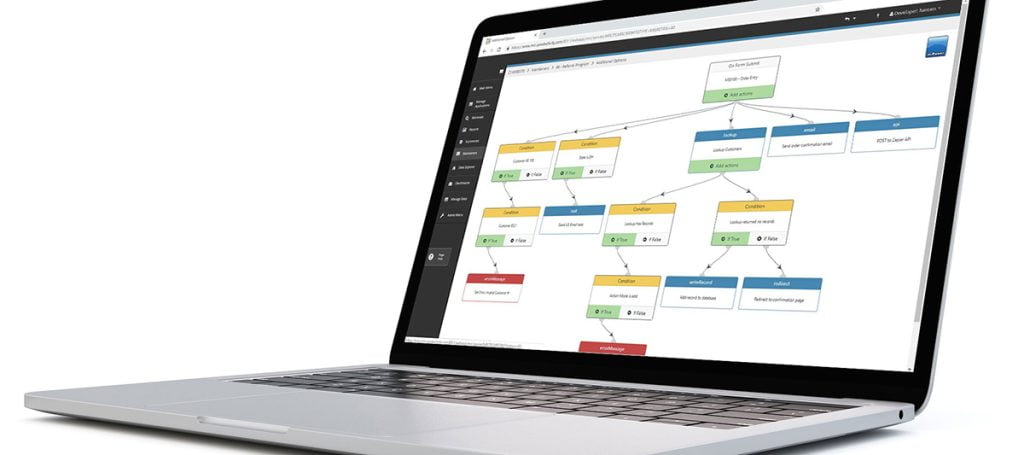
Looking for a good low-code platform is a lot like buying a car. There are many options out there, and they’re all different. Some look flashy. Others are plain.
But, over time, we care more and more about one thing: How it was made.
For instance, will you care about all of your car’s bells and whistles if it’s always in the shop? What if it only uses expensive, specialty parts that must be special ordered? What if it’s constantly giving you problems?
Low-code development tools are the same. There are many options out there, and they’re all different.
But, over time, you’ll care more and more about how it was made. The underlying architecture will play a massive role in your success or failure with the tool.
 How so? The architecture determines how well the tool integrates with other software/systems. If it’s not built for openness and flexibility, you’ll run into countless integration problems.
How so? The architecture determines how well the tool integrates with other software/systems. If it’s not built for openness and flexibility, you’ll run into countless integration problems.
Why is that so important? If you’ve ever used development software of any kind, you know how important integration is to your success. After all, do you really want another tool that lives on an island? Do you want more software that doesn’t really fit into your business?
Probably not.
The problem: How do you know which low-code tools are built on flexible architecture before you buy? How do you know whether or not you’ll run into integration issues?
The answer: Ask the right questions. Here are some of the most important integration questions to consider before investing in low-code:
- How will this low-code software fit into our existing tech stack?
Will it tie into your existing databases, ERP systems, CRM systems, etc…? Make sure you understand what this process will look like. - How will the applications it creates tie into our existing applications?
Can you embed the generated applications into your existing systems? Can you white-label the applications so they look and feel like they belong? - Will this work with both legacy and modern (and future) systems?
This speaks to how flexible the tool is when it comes to integration. - How difficult is it to integrate with third-party tools?
Many low-code tools have built-in integrations with other tools. But, integration isn’t always straightforward. Can you create your own API calls or web services? You don’t want to only rely on the vendor’s pre-built integrations. - Will this work with a hybrid-cloud (or even a multi-cloud) environment?
Many businesses use one or more cloud services in combination with their on-premise data/systems. Will the low-code tool seamlessly integrate with modern cloud environments like this? - Is it built on proprietary code or open standards/frameworks?
Many low-code tools operate as a “walled garden.” They’re built on proprietary architecture that limit your integration options. You need tools that are built on open code and standards. - Does it generate standard, human-readable code?
Now, most low-code tools won’t require you to dig into the generated code. But, it’s nice to have that option available. For instance, suppose you need to make a customization that’s not possible through the interface. You want the option to edit the code, even though that will rarely be necessary. - Do the applications run independently of the platform?
This speaks more to vendor lock-in than integration, but it’s still an important question. What happens if you ever stop using the platform? Will your applications stop functioning? To avoid this, make sure the applications run (and can be maintained) independently of the platform. - Do you have a services team that can help with integration if necessary?
Every business is different and has different integration needs. A services team that can help you through any custom integrations you might need is a valuable asset to have.
Of course, I’m just touching on these points. If you’d like to see a more in-depth look at what types of customization options you need in low-code tools, check out this video:
Why are these questions so important?
I know, I know…those are a lot of questions. Do you really need to ask all of them? These are important for a few reasons:
- They’ll help you avoid problems down the road
Have you ever started using a software product, only to run into a wall later on? Maybe you realized too late that it didn’t do everything you needed. Or, maybe you just ran into a limitation that held you back.
Chances are, you’d like to avoid that. While you can’t possibly plan for every future scenario, a well-architected platform will help. The questions above will help you identify flexible tools that can meet your present and future needs.
- Not all low-code tools are built for flexibility or integration
Over the past few years, there’s been an influx of low-code tools. Many of them focus on a flashy interface. Many advertise pre-built integrations.
But, if you’re hoping to use a low-code tool in an enterprise setting, be warned. If they’re not architected from the ground up for openness and integration…you’ll likely run into problems.
- Integration isn’t always straightforward
Are you planning to integrate a low-code platform with your existing databases and systems? If so, understand that these types of integrations aren’t always straightforward. It’s almost never just a simple integration out of the box.
Why? Every business is different. They have different software, environments, and security requirements. Sure, you may have an API endpoint. But, what will you do with the data you get back? Are there potential security concerns?
The key takeaway from all of this: Integration is almost never “out of the box.” You need a tool that is flexible enough to adapt to your needs…whatever they may be.
What should you look for?

When looking for a low-code platform, integration must be a primary concern. Obviously, you must ensure that it will integrate seamlessly with your existing tech stack. But, most importantly, find a platform that’s built for integration and customization.
Here at mrc, this is one of our primary concerns. Our development philosophy is simple: Low-code shouldn’t hold you back. It should fit into what you’re already doing. It shouldn’t limit your options…now or in the future.
That’s our goal with the m-Power Development Platform. It’s built around openness and flexibility. It’s for organizations that want low-code without customization limits or vendor lock-in. It’s for those who want an extendable low-code platform that’s not limited by what’s available out of the box.
On top of that, we offer consulting services should you ever need help with an integration or development project. Maybe you run into a challenging project or maybe you just want an application created quickly. While you might never need our help, it’s nice to have the option when needed.
Want to learn more? We’re happy to give you a demo and answer any questions you might have. Fill out this form to get started: https://www.mrc-productivity.com/aw/trial.html.